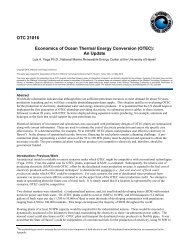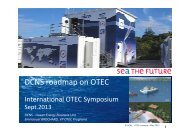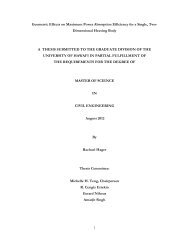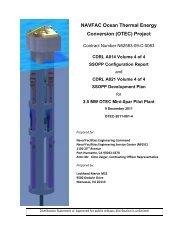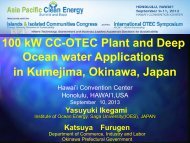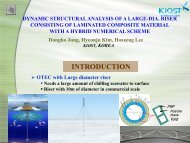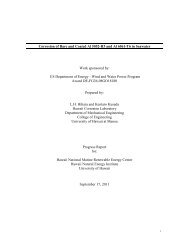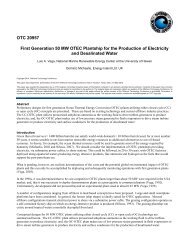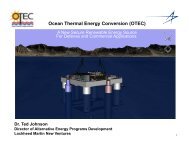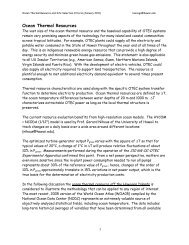Kim S_Seawater Heating and Cooling in Busan, Korea
Kim S_Seawater Heating and Cooling in Busan, Korea
Kim S_Seawater Heating and Cooling in Busan, Korea
Create successful ePaper yourself
Turn your PDF publications into a flip-book with our unique Google optimized e-Paper software.
Analysis of Proper Depth<br />
for Ga<strong>in</strong><strong>in</strong>g <strong>Seawater</strong> Heat<br />
for <strong>Heat<strong>in</strong>g</strong> <strong>and</strong> <strong>Cool<strong>in</strong>g</strong><br />
<strong>in</strong> <strong>Busan</strong>, <strong>Korea</strong><br />
• Samuel <strong>Kim</strong> (Dongeui University)<br />
• Ki-Chang Chang (<strong>Korea</strong> Institute of Energy Research)
1. Introduction<br />
• Use of heat from seawater could be different from the weather conditions<br />
of a coastal city <strong>and</strong> seawater temperatures near the city.<br />
• It is impossible to get deep sea water for <strong>Busan</strong> area, s<strong>in</strong>ce the<br />
maximum sea water depth around <strong>Busan</strong> is about 150m.<br />
• It will be a good option to use surface layer water with Heat Pump<br />
system for us<strong>in</strong>g seawater cool<strong>in</strong>g/heat<strong>in</strong>g <strong>in</strong> <strong>Busan</strong>.<br />
• The study <strong>in</strong>vestigates the proper depth for seawater heat ga<strong>in</strong> of <strong>Busan</strong><br />
area <strong>in</strong> <strong>Korea</strong> : Sampl<strong>in</strong>g po<strong>in</strong>ts are 0, 10, 20, 30, 50m from the surface<br />
of the Sea.<br />
• Proper seawater <strong>in</strong>take depth for heat<strong>in</strong>g <strong>and</strong> cool<strong>in</strong>g <strong>in</strong> <strong>Busan</strong> is<br />
suggested, through <strong>in</strong>vestigat<strong>in</strong>g the temperature of seawater accord<strong>in</strong>g<br />
to the depth
2. Examples of seawater heat source facilities<br />
<strong>Korea</strong>n Cases<br />
KIOST<br />
* Use of Deep <strong>Seawater</strong> for Air<br />
condition<strong>in</strong>g of the build<strong>in</strong>g.<br />
* A small size pilot project (60RT)<br />
* About 86% of cool<strong>in</strong>g energy is<br />
saved.<br />
<strong>Korea</strong> Maritime University<br />
* 75RT Size <strong>Heat<strong>in</strong>g</strong> <strong>and</strong> <strong>Cool<strong>in</strong>g</strong><br />
System us<strong>in</strong>g Plate-type Heat<br />
Exchanger.<br />
* Flow Rate : 60m 3 /h ,<br />
COP for <strong>Cool<strong>in</strong>g</strong> : 7<br />
COP for <strong>Heat<strong>in</strong>g</strong> : 6.8<br />
* About 70% of electricity energy<br />
is saved.
3. Analysis of seawater temperature<br />
30.00<br />
25.00<br />
Temperature (°C)<br />
20.00<br />
15.00<br />
10.00<br />
5.00<br />
Po<strong>in</strong>t 1<br />
207 Area<br />
0.00<br />
FEB APR JUN AUG OCT DEC<br />
0m 10m 20m 30m 50m<br />
Po<strong>in</strong>t 1 of 207 Area<br />
207 Area Po<strong>in</strong>t 1 Po<strong>in</strong>t 2 Po<strong>in</strong>t 3<br />
Distance 2km 14km 22km<br />
Depth 84m 103m 115m<br />
• Temperature Analysis for Sea<br />
Water at Po<strong>in</strong>t 1 of 207 area<br />
between 2000 <strong>and</strong> 2011.<br />
• The temperature of surface water<br />
fluctuates accord<strong>in</strong>g to the season,<br />
while that of deep sea water is<br />
constant.
3. Analysis of seawater temperature<br />
Po<strong>in</strong>t 1 of 207 Area<br />
30<br />
30<br />
Temperature (°C)<br />
25<br />
20<br />
15<br />
10<br />
5<br />
Temperature (°C)<br />
25<br />
20<br />
15<br />
10<br />
5<br />
depth<br />
0m<br />
0<br />
FEB APR JUN AUG OCT DEC<br />
depth<br />
30m<br />
0<br />
FEB APR JUN AUG OCT DEC<br />
Temperature (°C)<br />
Temperature (°C)<br />
30<br />
25<br />
20<br />
15<br />
10<br />
5<br />
0<br />
depth<br />
10m<br />
30<br />
25<br />
20<br />
15<br />
10<br />
depth<br />
20m<br />
5<br />
0<br />
FEB APR JUN AUG OCT DEC<br />
FEB APR JUN AUG OCT DEC<br />
2011 2010 2009 2008 2007 2006<br />
2005 2004 2003 2002 2001 2000<br />
Temperature (°C)<br />
depth<br />
50m<br />
30<br />
25<br />
20<br />
15<br />
10<br />
5<br />
0<br />
FEB APR JUN AUG OCT DEC<br />
• <strong>Seawater</strong> temperature does not<br />
change significantly accord<strong>in</strong>g to<br />
the depth <strong>in</strong> w<strong>in</strong>ter, while the<br />
temperature is quite different<br />
accord<strong>in</strong>g to the depth <strong>in</strong> summer.<br />
Comparison Parts
4. Energy potential of seawater heat source<br />
• Q is an energy potential of seawater heat source<br />
Q = ρ * Cp * W * ∆t<br />
ρ : density of seawater(1,025kg/m 3 ) Cp : Specific heat (0.942kcal/kgK)<br />
W : flow (10 4 m 3 /month/m) ∆t : temperature difference<br />
∆t FEB APR JUN AUG OCT DEC<br />
0m 4.84 1.28 4.33 10.07 0.8 6.75<br />
10m 4.71 1.45 5.36 10.24 1.17 6.67<br />
20m 4.34 1.94 7.96 14.66 8.72 6.24<br />
Gcal/month<br />
250000<br />
200000<br />
150000<br />
100000<br />
50000<br />
0<br />
2 4 6 8 10 12<br />
Month<br />
Energy potential is the<br />
biggest <strong>in</strong> summer<br />
depend<strong>in</strong>g on the<br />
temperature difference.<br />
When the water level is<br />
deeper, the energy<br />
potential becomes<br />
bigger.<br />
0m 10m 20m
5. Analysis of cost for seawater <strong>in</strong>take pipes<br />
• If the heat pump with 150A HDPE pipes is operated, the cost per pipe<br />
length(m) is 27,100 Won.<br />
• The distance form the coast of 0 m depth below sea level is 0.095 km, that<br />
of 10 m depth is 0.476 km, <strong>and</strong> that of 20 m is 1.19 km<br />
• The cost of pipes for the <strong>in</strong>take depth of 0 m is 2.6 million Won, that of 10 m<br />
is 130 million won, <strong>and</strong> that of 20 m is 320 million Won.<br />
Won<br />
50,000,000<br />
45,000,000<br />
40,000,000<br />
35,000,000<br />
30,000,000<br />
25,000,000<br />
20,000,000<br />
15,000,000<br />
10,000,000<br />
5,000,000<br />
0<br />
0m 10m 20m<br />
Depth<br />
Energy potential Cost<br />
35,000,000<br />
30,000,000<br />
25,000,000<br />
20,000,000<br />
15,000,000<br />
10,000,000<br />
5,000,000<br />
0<br />
Gcal/day∙°C<br />
US$ 1 ≒ <strong>Korea</strong>n Won 1,100<br />
• The energy potential<br />
between 0m <strong>and</strong> 10m<br />
depth is similar.<br />
• The cost of <strong>in</strong>take pipes<br />
varies by the distance<br />
from the coast <strong>and</strong><br />
seawater depth level.
6. Conclusion<br />
• The temperature difference accord<strong>in</strong>g to the depth of seawater is<br />
relatively big dur<strong>in</strong>g August, while it is almost the same from October to<br />
April.<br />
• The <strong>in</strong>stall<strong>in</strong>g cost for <strong>in</strong>take pipes for 20m depth is about 3 times higher<br />
than that for 10m.<br />
• Although the COP of the system us<strong>in</strong>g deeper seawater is higher than<br />
that us<strong>in</strong>g shallower seawater, the <strong>in</strong>itial cost of the system us<strong>in</strong>g deeper<br />
seawater is much higher that that us<strong>in</strong>g shallower seawater.<br />
• Use of seawater from 10m depth is more economical than that from 20m.



